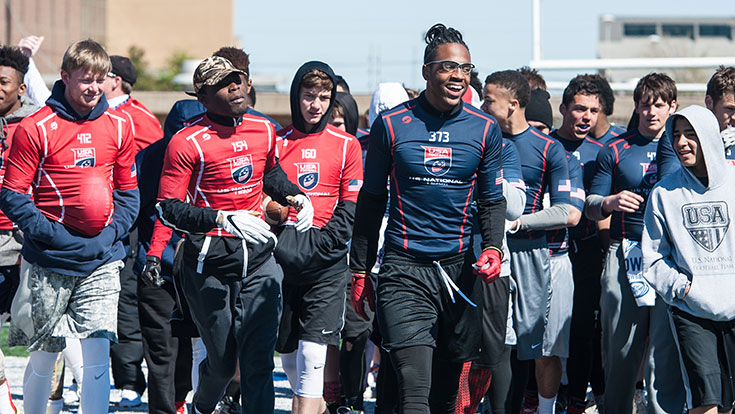7 ways to prepare for Regional Development Camps

From Los Angeles to Washington, D.C., athletes across the nation are working hard this offseason and training to take part in U.S. National Team Regional Development Camps.
It’s been three or four months since the football season ended, and athletes need to make sure their bodies and minds are up for the task at hand.
Regional Development Camps include two days of training and competition for athletes in sixth through 11th grades. U.S. National Team instructors include top area high school and NCAA coaches. As the national governing body of the sport, USA Football has received an exemption from the NCAA to employ current college coaches at its camps.
Whether new to the event or a returning veteran, there are a number of ways to prepare to be your best.
Jimmy Thomas, former National Teams operations manager and camp director, shared what he sees as the keys to succeed.
Stay active
Players attending Regional Development Camps need to make sure that their bodies are adequately prepared to endure the intensity of a two-day camp filled with drills they haven’t gone through in weeks – possibly months.
For athletes taking part in winter sports, this is likely already taken care of. For those who have done little activity beyond some weight room work since football ended, it’s time to get the body moving.
“You don’t want to come in cold,” Thomas said. “We run the 40-yard dash on Day 2. I’ve seen athletes who are too sore from Day 1 have their times impacted because of it. Staying active leading up to camp will help you throughout the weekend.”
Stretch before and after workouts
Stretching goes hand-in-hand with preparation. And the key is proper stretching. Touching your toes a few times or a few jumping jacks won’t do the trick. Use dynamic warmups to get your blood pumping and yourself ready for hard workouts.
“Stretching helps you avoid injuries,” Thomas said. “You need to be stretching before and after workouts to make sure you are staying on the field.”
Cardio and stamina
It doesn’t matter what position athletes play, players at RDCs need to be in football shape.
Athletes should be able to participate in their respective individual and team drills at a high level.
“We keep a high-paced environment. We get in and out of drills quickly,” Thomas said. “A receiver might have to go from running individual drills right into 7-on-7, so by the end of the day, he’ll have to run a tremendous amount of routes. A quarterback will have to throw a tremendous amount of balls. If you’re sore by the end of Day 1, who knows how effective you’ll be on Day 2.”
Maintain a healthy diet
Eating the right things is not something athletes can turn on and off and expect to be in the best condition. Eating right now goes toward building good habits and strong life choices.
“You need to have a diet with a purpose,” Thomas said. “Not only leading up to the event but just to be a productive athlete. Make sure you fuel your body properly so you are able to perform at your optimum level.”
Or as put by Super Bowl 50 Most Valuable Player Von Miller, who got sick and had to miss a practice this past January after eating a bad batch of mozzarella sticks from a local movie theater: “You can’t put regular gas in a Ferrari.”
Hydration
Proper fluid intake means drinking water before you even get to the field. Athletes should consume 16 to 24 ounces of water in the lead up to Day 1 just to be sure they are hydrated correctly.
Then keep consuming water throughout the two days.
“You never want to miss out on a drill or an opportunity to excel because you’re sitting out with a cramp,” Thomas said.
This goes for RDCs in typically warm-weather cities and in the north.
“In the cold weather, you don’t always realize the fluids you’re losing because you’re not visibly sweating as much,” Thomas said. “But it’s just as important to hydrate.”
Mental preparedness
Drills and practices can serve as a showcase for football skills, but athletes also should be prepared to prove themselves as a person. Members of the U.S. National Team represent not only the best players nationwide but those who exude the leadership and responsibility to represent our country.
“The first thing that is evaluated is your coachability,” Thomas said. “If a coach doesn’t think he can make you better, then he’s probably not going to spend a lot of time with you. Coaches are looking for athletes that can make their program better and make the U.S. National Team better. Those athletes are coachable athletes.”
Ask yourself why?
Every football player has his own story, their own reasons for playing the game, their own goals and plans for future.
Athletes participating at a Regional Development Camp should take the time to think of how they can make the most out of their experience.
Regional Development Camps are more than just a weekend filled with drills and practices. They are opportunities to help athletes as they continue their football careers.
“Why are you here? Do you want to become a member of the U.S. National Team? Are you there to be recruited?” Thomas said. “Come prepared with questions for the coaches that are going to be there, as well as questions that they are going to ask you.
“Every athlete has the opportunity to get better. You should take home at least one thing that will make you a better athlete.”
